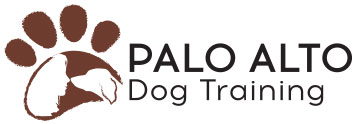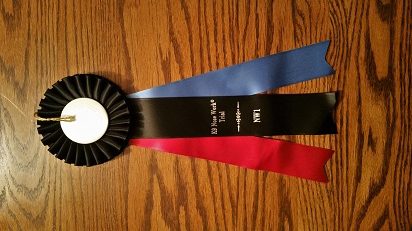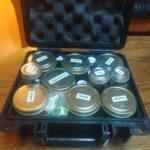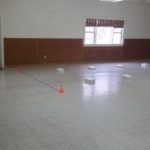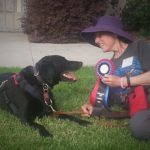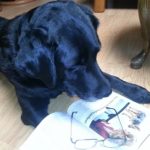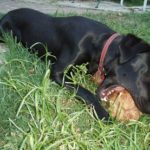What kinds of searches can you expect in an NW1 Trial? How should you prepare, as you train in K9 Nose Work? What will you and your dog be expected to do? Are you ready? Do you and your dog have what it takes, to compete in an NW1 Trial?
The Elements
NW1, NW2, and NW3 Nose Work Trials consist of four Elements:
- Containers
- Exteriors
- Interiors
- Vehicles
The Certifying Official (CO) sets the search areas, and then sets each hide. In the NW1 Trial, the CO sets one search in each Element, and one hide in each search.
The hide could be Birch, Anise, Clove, or any combination of those.
The CO also sets a time limit for each search: generally about two to three minutes per search. The fastest dogs may complete the search in well under 30 seconds. In fact, the fastest dogs in an NW1 Trial sometimes have a combined time, for all four searches, of a minute or two. Times vary for each Trial, depending on hide placement, search area characteristics, and weather conditions. Dave and Bodie, and Tigger and I, had combined search times of just under two minutes, in our NW1 Trials.
All NW1 Trial Elements
For each search in an NW1 Trial, the CO will set a Start Line, with cones, flags, or blue tape. Your dog should pass over the Start Line; you may get a fault if your dog veers off to either side, like mine did in our NW1 Containers Search. My dog Tigger veered left too soon, chasing odor, so I took a tight circle with him, to get him over the actual Start Line. This wasted time and probably confused him. Speaking from experience, I recommend that you choke up so that your dog is on a very short leash, or hold on to the harness, until after you cross the Start Line.
Your dog needs to find the hide, and communicate that to you, with either a natural or trained Alert. Then you say ALERT! If the Judge says YES, reward your dog! Congratulations! Party time! You’ve passed that element! If the Judge says NO… better luck next time.
In an NW1 Trial (but not at higher level Trials), if your dog times out, or you Alert in the wrong place, the Judge will tell you where the hide is, so you can reward your dog at source. If this happens, you should take your dog directly to the hide; don’t make everyone wait while you tell your dog to Search again.
Once you finish your search, volunteers will help guide you and your dog back to the competitor parking lot. While you don’t need to race, please don’t hang around in the Search Area, once you’re done. Move on, to allow the next competitor to enter the area. If you need to change your dog’s lead or make other equipment changes, you will help the Trial run smoothly by getting out of view of the search area, before doing so.
Containers
In an NW1 Trial, you and your dog will search cardboard boxes of various sizes and shapes, or any combination of sizes and/or shapes. In addition, plastic shoe boxes with holes punched in the tops, are now allowed. The CO will place hide inside one box; the other boxes will be blank. Leashes are generally required in a Containers search.
I encourage you to check out these examples from the NACSW website. This is Chili and I in our first place Containers search in the Yamhill Oregon NW1, July 2021:
To prepare for Containers, make sure your dog gets practice searching for a single hide in up to about 20 closed cardboard boxes. Practice on various surfaces if you can (carpeting, tile, linoleum, wood, dirt, etc) because odor will behave differently in each of those cases. If you can, arrange to have air movement blow down the row of boxes, so your dog learns to go all the way to the Source box, without Alerting on a nearby box which merely has odor blowing onto it. Be aware, it is very possible that your Containers search will feature slippery floors.
In Containers, you can get a fault for dropping food in the search area, or for touching any of the Containers. Your dog can get a fault for excessively damaging a Container. By the way, dog slobber is NOT considered a fault! Whew!
Exteriors
If the search area is not entirely enclosed by fencing or walls, volunteers will clearly mark the search area with cones, flags, or tape. The hide will be inside the search area. You and/or your dog may leave the search area without penalty; after all, your dog may wish to follow the odor plume outside of the search area. If the area is completely enclosed, you may have the option to run this search on or off leash. Most Exteriors searches are not safe for off-leash searches, however, so leashes are almost always required.
I encourage you to check out these examples from the NACSW website. This is Dave and Bodie’s first place Exteriors search in the Livermore California NW1, October 2012:
To prepare for Exteriors, your dog should be familiar with doing Nose Work on various outdoor surfaces, from wooden decks to concrete and pavement, from lawns to dirt/gravel. There may be trees and/or bushes in your Exteriors search area. Your dog should also be familiar with searching benches and picnic tables.
The two biggest concerns people usually have about Exteriors are:
- Your dog may eliminate during the search (in which case, you will be eliminated from the search)
- Your dog may be distracted by outdoor odors, and/or outdoor wildlife
Work with your Instructor until you are fairly confident in both areas.
In Exteriors, you can get a fault for dropping food in the search area, or touching or moving anything in the search area. Your dog can get a fault for damaging the search area, but this is extremely rare in an Exterior search.
Interiors
In an NW1 Trial, sometimes the search area is the entire room; other times, cones or tape will mark your the search area within the room. Interiors searches frequently offer the on-leash or off-leash option. If you have an off-leash option, you may take the leash on or off as often as you like, during the search.
I encourage you to check out these examples from the NACSW website. This is Java and Dave in their Interiors search in the San Jose NW1, November 2022:
To prepare for Interiors, make sure your dog gets practice searching in a variety of indoor spaces. Practice on various surfaces if you can (carpeting, tile, linoleum, wood, etc) because odor will behave differently in each of those cases. If you can, arrange to have air movement sometimes, and no air movement others. Opening windows can be enough to create a small breeze. Practice in big rooms and small rooms; cluttered rooms and nearly empty rooms. Be aware, it is very possible that your Interiors search will feature slippery floors.
In Interiors, you can get a fault for dropping food in the search area, or for touching anything. Your dog can get a fault for excessively damaging anything in the room.
Vehicles
The CO will place one hide on a vehicle, in an NW1 Trial. There may be up to 5 vehicles in a Vehicles search. The vehicles may be cars, trucks, SUVs, golf carts, tractors… almost anything with at least 3 wheels. The dogs never go inside the Vehicles. The search may be indoors, or more frequently outdoors. Almost always, leashes will be required.
I encourage you to check out these examples from the NACSW website. This is Tigger and I in his first place Vehicles search in the Livermore California NW1, October 2012:
To prepare for Vehicles, your dog should have experienced finding hides behind license plates, around the bumper area and running boards (depending on the type of vehicle), and in and around the wheel wells. Practice from upwind, and from downwind, of the Vehicles; and practice when there is no wind at all. Practice having your dog go around the Vehicle to get to the hide.
In Vehicles, you can get a Fault for dropping food in the search area, or for touching a Vehicle. Your dog can get a fault for:
- Diving too far underneath a Vehicle (safety concerns), or
- Damaging a vehicle by
- Jumping up on it, or
- A too-vigorous Alert with a paw
Weather
You and your dog should have practice searching in the kind of weather that you will expect at the Trial. So, that means you have to get out and practice in heat, cold, wind, and rain, if your Trial will be at the time of year that you’re likely to encounter those conditions. Weather conditions can vastly change the movement of odor. Your dog should have experience finding odor in Trial day weather, before arriving at the Trial. And you should know what it looks like when your dog searches in those weather conditions.
Perfection
The NW1 Trial demands perfection, all in one day. To receive your NW1 Trial Title, you and your dog must find all of the hides within the time limits, but no “extras” (calling Alert where there is actually no source of odor).
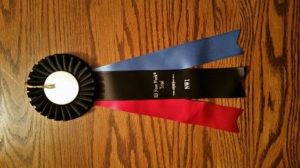
The NW1 Trial showcases your dog’s skills:
- Ignore the environmental distractions, in a new and unfamiliar location
- Solve a simple odor puzzle
- Find and alert on odor within the time limit
You must be able to read your dog well enough to call the Alert; other than that, the NW1 is mostly about the dog.
Entry Process
The entry process for all NACSW Trials is the same. The NACSW will announce an Entry Date. Starting on the Entry Date at 9AM Pacific Time, you’ll have 48 hours to submit your entry. After those 48 hours, the NACSW holds a lottery draw to determine who will compete. If you are one of the lucky ones, the Trial Host will send you an acceptance email, including payment instructions. To hold your spot, you will need to pay by the deadline included in the email. Some hosts ask for a check to be mailed; others accept payment over the internet. If you didn’t get in, you will be put on the wait-list. Don’t give up hope: sometimes the wait list moves quite a bit, and you might get in, after all.
The NW1 Trial: The Day Before
Review everything else you need to know about a Trial. Make sure you read the Rule Book again — even if you’ve already read it many time before. Review your Trial notification email to verify the times, and any special instructions. Calculate how long it will take to get there, and what time you should get on the road. Put together everything you’ll want with you at the Trial, so you won’t get there and realize some things you need are still at home. Set your wake-up alarm. Then, get a good night’s sleep.
Plan to wear something comfortable and weather-appropriate. Almost all NW1 Trials have one or more official photographers, and/or professional videographers, so it’s wise to avoid wearing your least flattering outfits. I feel more confident when I wear my jalapeño hot pepper earrings as a good luck charm; perhaps you have something lucky to wear as well.
The Certifying Official will post a walk-through video of your search areas, the night before the Trial. You can find the videos here.
The NW1 Trial: The Day Is Here!
Here’s some advice that easy to give and hard to follow:
- Try to relax. You won’t be able to think straight if you’re tense. Your dog may be worried about your anxiety, and that may interfere with his desire to search.
- Have fun with your dog. You get to spend the whole day with your dog, doing something that hopefully both of you love: Nose Work.
- Be supportive of your fellow competitors. In Nose Work, you essentially compete only against yourself. Every single canine/handler team there can get a Title if they have a perfect day.
- If you don’t have that perfect day, think of it as a learning experience, instead of as a disappointment. You learned where there may be a hole in your training.
And some advice that’s easy to follow: Volunteer at as many Trials as you can. It’s a terrific educational opportunity that’s completely free. You meet new people who are also crazy about Nose Work. You get free food. You’ll be more prepared for your own Trials. Dave and I volunteer at every Trial we can, and we’re always glad that we did.
After the Trial
After the Trial, record your impressions. Watch the Virtual Debrief Videos posted by the Certifying official. If your trial offered video services, purchase your videos; they are a wonderful keepsake, and a wonderful learning opportunity. What went well? What would you like to work on? Did the Trial reveal any holes in your training? Your instructor may provide additional insight.
You may also wish to record everything in the NACSW’s Competition Log Book, designed specifically to keep track of all of your NACSW Trial results. You can record information about you and your dog, your ORT details, and search details and results from all of your Nose Work Trials.
Copyright 2017 by Linda Fletcher; updated 2022
